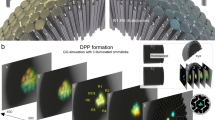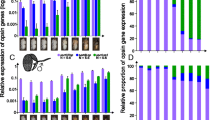Summary
It has recently been claimed (Ribi 1979, 1980) that “bee ommatidia show no twist” and that our earlier finding of rhabdom twist in bees (Wehner et al. 1975; forMyrmecia ants see Menzel and Blakers 1975) had been due toartefactual twisting of the rhabdoms. In this paper we present new histological data substantiating our previous hypothesis that bee rhabdoms twist in vivo. In addition, we demonstrate that Ribi's longitudinal section (Ribi 1979; Fig. 1) through part of a bee's rhabdom does not provide compelling evidence against the hypothesis of rhabdomeric twist.
-
1.
Rhabdomeric twist is found in preparations in which special care was taken not to cut the eye (glutar-aldehyde fixation) or even the whole head (acrolein fixation) during the processes of preparation and fixation. Thus, changes in intraocular pressure that might be one cause of artefactual twist have been reduced to a minimum in both the whole-eye and the whole-head preparations. On the other hand, even when the retinal tissue is mechanically manipulated, e.g. by compressing the compound eye or by excising the retina, the rhabdoms twist as in the usual preparations. The direction of twist (clockwise or counter-clockwise) is always correlated with the geometry of the rhabdom (X-type rhabdoms or Y-type rhabdoms). The twist rate is about the same in the whole-eye preparations, the manipulated-eye preparations, and the isolated-retina preparations. Besides the absence of structural pecularities like disrupted membranes or enlarged intercellular clefts, there is some further support for the hypothesis that artefactual twist does not occur: Slender processes of the secondary pigment cells invade the intercellular clefts between adjacent photoreceptor cells but never show any signs of being sheared off or distorted. Furthermore, membrane junctions can regularly be found between secondary pigment cells belonging to different retinulae.
-
2.
Ribi's (1979) electron micrograph presenting a relatively short longitudinal section through a bee's rhabdom does not allow for the conclusion that the rhabdoms of bees are straight. This is mainly a consequence of the fact that the section of the rhabdom shown in his figure was cut at about right-angles to its microvilli instead of parallel to them. It follows from simple geometrical considerations that the cut microvilli can appear rather circular even in the presence of substantial amounts of twist.
Similar content being viewed by others
References
Bernard GD, Wehner R (1977) Functional similarities between polarization vision and color vision. Vision Res 17:1019–1028
Bernard GD, Wehner R (1980) Intracellular optical physiology of the bee's eye. I. Spectral sensitivity. J Comp Physiol 137:193–203
Burghause F (1976) Adaptionserscheinungen in den Komplexaugen vonGyrinus natator L. (Coleoptera: Gyrinidae). Int J Morphol Embryol 5:335–348
Chi C, Carlson SD, St. Marie RL (1979) Membrane specializations in the peripheral retina of the houseflyMusca domestica L. Cell Tissue Res 198:501–520
Eisen JS, Youssef NN (1980) Fine structural aspects of the developing compound eye of the honey bee,Apis mellifera L. J Ultrastruct Res 71:79–94
Hayat MA (1970) Principles and techniques of electron microscopy, vol 1. Van Nostrand Reinhold, New York
Herrling PL (1976) Regional distribution of three ultrastructural retinula types in the retina ofCataglyphis bicolor (Formicidae, Hymenoptera). Cell Tissue Res 169:247–266
Kirschfeld K (1972) Die notwendige Anzahl von Rezeptoren zur Bestimmung der Richtung des elektrischen Vektors linear polarisierten Lichtes. Z Naturforsch 27b: 578–579
Labhart T (1980) Specialized photoreceptors at the dorsal rim of the honeybee's compound eye: Polarizational and angular sensitivity. J Comp Physiol 141:19–30
Labhart T, Meyer E (1980) Ultrastructural and electrophysiological studies on a specialized area of the honey bee's eye. Experientia 36:698
Menzel R, Blakers M (1975) Functional organization of an insect ommatidium with fused rhabdom. Cytobiologie 11:279–298
Menzel R, Blakers M (1976) Colour receptors in the bee eye — morphology and spectral sensitivity. J Comp Physiol 108:11–33
Menzel R, Snyder AW (1974) Polarised light detection in the bee,Apis mellifera. J Comp Physiol 88:247–270
Mote MI, Wehner R (1980) Functional characteristics of photoreceptors in the compound eye and ocellus of the desert ant,Cataglyphis bicolor. J Comp Physiol 137:63–71
Muller LL, Jacks TJ (1975) Rapid chemical dehydration of samples for electron microscopic examinations. J Histochem Cytochem 23:107–110
Perrelet A (1970) The fine structure of the retina of the honey bee drone: an electron-microscopical study. Z Zellforsch 108:530–562
Räber F (1979) Retinatopographie und Sehfeldtopologie des Komplexauges vonCataglyphis bicolor (Formicidae, Hymenoptera) und einiger verwandter Formiciden-Arten. Dissertation, Universität Zürich
Ribi WA (1979) Do the rhabdomeric structures in bees and flies really twist? J Comp Physiol 134:109–112
Ribi WA (1980) New aspects of polarized light detection in the bee in view of non-twisting rhabdomeric structures. J Comp Physiol 137:281–285
Schinz RH (1975) Structural specialization in the dorsal retina of the bee,Apis mellifera. Cell Tissue Res 162:23–34
Shaw SR (1978) The extracellular space and blood-brain barrier in an insect retina: An ultrastructural study. Cell Tissue Res 188:35–61
Smola U, Tscharntke H (1979) Twisted rhabdomeres in the dipteran eye. J Comp Physiol 133:291–297
Smola U, Wunderer H (1981) Fly rhabdomeres twist in vivo. J Comp Physiol 142:43–49
Sommer E (1979) Untersuchungen zur topographischen Anatomie der Retina und zur Sehfeldtopologie im Auge der Honigbiene,Apis mellifera (Hymenoptera). Dissertation, Universität Zürich
Walcott B (1975) Anatomical changes during light-adaptation in insect compound eyes. In: Horridge GA (ed) The compound eye and vision of insects. Clarendon Press, Oxford, pp 20–33
Wehner R (1976) Structure and function of the peripheral visual pathway in hymenopterans. In: Zettler F, Weiler R (eds) Neural principles in vision. Springer, Berlin Heidelberg New York, pp 280–333
Wehner R, Bernard GD (1980) Intracellular optical physiology of the bee's eye. II. Polarizational sensitivity. J Comp Physiol 137:205–214
Wehner R, Bernard GD, Geiger E (1975) Twisted and non-twisted rhabdoms and their significance for polarization detection in the bee. J Comp Physiol 104:225–245
Author information
Authors and Affiliations
Additional information
This work was supported by Swiss National Science Foundation grant 3.313-0.78. We are grateful to Prof. G.D. Bernard (Yale Medical School, New Haven) for performing the calculations described on p. 16.
Rights and permissions
About this article
Cite this article
Wehner, R., Meyer, E. Rhabdomeric twist in bees — Artefact or in vivo structure?. J. Comp. Physiol. 142, 1–17 (1981). https://doi.org/10.1007/BF00605471
Accepted:
Issue Date:
DOI: https://doi.org/10.1007/BF00605471




